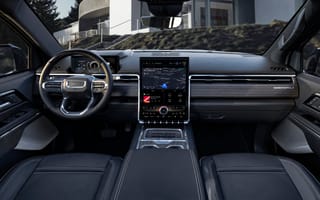When General Motors President Mark Reuss debuted the company’s all-new platform in 2019 during the Wall Street Journal’s Future of Everything festival, the vehicle manufacturer’s journey toward interconnected electric innovation was just beginning.
GM’s platform is designed to uphold the next generation of the company’s products and capabilities. To enhance the driver experience, the platform’s infotainment solution centralizes informative elements such as maps with entertainment features like music apps.
Executive Director of Product Management for Infotainment, Charging and Viewing Mike Hichme helped lead the design and development of the infotainment solution’s graphical user interface and most of its application software. Hichme shared that the infotainment solution brings many features together in a freeform display format — and, as it unifies these different capabilities, the technology updates itself without manual intervention, delivering a seamless experience.
“Customers expect the latest in terms of technology in their new vehicle,” Hichme explained. “We’re entering an era of vehicles improving as they age through regular software updates, and the level of integration between the navigation system and other functions of the vehicle, such as the EV charging experience, has grown in importance.”
Bringing the solution to life was a complex undertaking that required his team to leverage the latest technologies and right practices to overcome any challenges that got in their way. Yet despite the hurdles they faced, Hichme expressed, the hard work that went into building the product was worthwhile, as it enabled him and his teammates to help drive an industrywide evolution.
“It’s an exciting time to be working in the automotive industry, as transportation goes through a transformative period across electrification, autonomy and software,” he said.
Below, Hichme shares more about how his team created GM’s new infotainment solution, the impact it will have on the company’s customers and how its inception reflects the company’s “one-team attitude” toward product development.
GM’s Intelligence Platform
The infotainment solution Hichme and his peers built is simply one component of GM’s new intelligence platform, which forms an electrical architecture that is five times as powerful as the company’s previous one, according to an article on the organization’s website. The new platform is fueling the evolution of the company’s vehicles and EVs, active safety capabilities, infotainment and connectivity features and Super Cruise driver assistance feature.
What product is your team excited about right now?
As screens and connected experiences in vehicles become increasingly important, it has been rewarding to work on our new infotainment system. It’s launching in our latest EVs and brings drivers’ favorite apps and features — such as maps, music and voice assistants — front and center. It also introduces our freeform display technology, where the shape of the display is not a strict rectangle or a mere projection of a phone screen.
The goal is to bring the vehicle’s hardware and software together with apps working seamlessly alongside vehicle settings, all of which is accessible from the infotainment screen. The built-in infotainment experience works especially well with maps, which are integrated with the EV experience. If you set a route, it will forecast the battery percentage at your destination using various factors, such as the weight of the vehicle, the resistance of the tires, elevation and road geometry.
What role did you play in developing the infotainment solution, and what tools did your team use to build it?
I led the design and development of the graphical user interface and most of the application software. The driver information display software was developed in C++ and runs on QNX OS, while the infotainment and entertainment functions are developed in Kotlin and run on Android OS. From an interface design perspective, our designers use Sketch, Figma, Illustrator, Photoshop and various 3D rendering tools.
How did you keep team members motivated and aligned throughout the product development process?
We have a continuous integration and deployment pipeline and we keep a fleet of vehicles along with lab-based test properties running around the clock.
One of the best mechanisms I used to keep the team focused on problem-solving and moving forward was a daily sync meeting with all the pertinent engineers on the project. Sometimes, we’d sync more than once a day. This constant communication, coupled with a “team of teams” approach, kept the team focused and moving forward.
What teams did you collaborate with in order to get this solution across the finish line?
Our teams are extremely cross-functional and include software designers, software engineers, hardware engineers, program managers, product managers and several more disciplines. Over the years, we’ve found the most effective way to ensure smooth collaboration is to have a good time architecture — the daily and weekly cadence of touch points — that all the team members understand. We also have a well-defined development process with milestones and gates that team members use to plan their individual work.
When you think of other companies in your industry, how does GM compare when it comes to building and launching new products?
It’s an exciting time to be working in automotive, as transportation goes through a transformative period across electrification, autonomy and software. With GM, there’s a huge opportunity to get the chance to scale work across brands — which includes a broad portfolio of EVs — and develop new technologies.
“With GM, there’s a huge opportunity to get the chance to scale work across brands — which includes a broad portfolio of EVs — and develop new technologies.”
I’ve been at GM for nearly 18 years, and what keeps me here are the people and the culture. I’m constantly learning and finding new opportunities to contribute to important projects with talented colleagues. People have a one-team attitude toward problem-solving and are passionate about the products we build.






